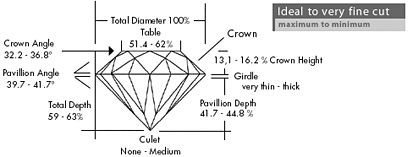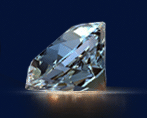
CertificationEvery Bellataire diamond over 3/4 carats comes with a grading report from the Gemological Institute of America (GIA). This report describes the shape, cut, size, weight, finish, clarity, color, and symmetry of your diamond. |
Carat WeightA gemstone’s size is measured in carat weight, where one carat equals 1/5 of a gram. A carat can be subdivided into 100 points, used to measure stones under one carat. For example, a diamond weighing 50 points is half of a carat. In stones of similar color, clarity, shape, and cut, higher carat weight raises the value of a diamond. However, large stones of one carat or more increase in value exponentially due to their rarity. When determining value, size is only one of the “4C” factors. Below is an approximate chart for round stones. |
Bellataire Diamonds are the finest diamonds in nature, restored to their spectacular beauty through a patented High Pressure/High Temperature Process.

ClarityMost natural diamonds contain microscopic traces called inclusions. In general, the fewer the inclusions, the more valuable the diamond. The Gemological Institute of America (GIA) grades clarity on a scale from “Flawless,” meaning undetected inclusions using 10X magnification, to “Imperfect.” Flawless or internally flawless stones are extremely rare and are graded as FL or IF. Stones with minor flaws are also very rare and are graded as VVS1 or VVS2 (Very, Very Slightly Included) or VS1 or VS2 (Very Slightly Included). Diamonds with a few noticeable flaws are graded SI1-SI2 (Slightly Included), and those with numerous visible imperfections are graded I1-I3 (Included). Although inclusions affect the value of a diamond, their importance should be considered in combination with the other characteristics. |
Clarity Grades |

ColorWhile many diamonds appear to be white to the untrained eye, almost all contain tiny tints of color caused by added nitrogen or misplaced carbon atoms during formation. Gemologists describe the color of diamonds beginning with D (colorless) all the way to Z (dark tinted). D, E, and F colors are more expensive because they are more rare. Nature also produces very rare stones with distinct ‘fancy’ colors such as yellow, blue, pink, green, orange, red and brown. |
Color Scale |

CutNot be confused with the shape of a diamond, cut refers to the arrangement of a diamond’s facets (cut planes). Cut is the most important of the 4C’s because it determines the optimum combination of brilliance, dispersion, and scintillation. Cut, under man’s control, has the greatest effect on a diamond’s beauty. A precisely cut diamond captures and releases the maximum play of light to cause the dazzling sparkle. It is important to note that if a diamond is poorly cut, light entering from above will leak out of the sides and bottom, and the stone will be without sparkle or fire. We are able to offer hand-cut diamonds that are exceptionally proportioned and are cut to maximize the beauty of the diamond. |

Ideal to Very Fine Cut (maximum to minimum) |
ShapeShape gives a diamond its character. “Fancy” shapes include the Marquise, an elongated Oval with pointed ends; the Pear which forms a teardrop; and the Heart that has an added notch at the rounded end of a Pear Shape. The traditional Round Brilliant design has 58 facets divided among the crown (top), girdle (widest part), and pavilion (base) of the diamond. |


